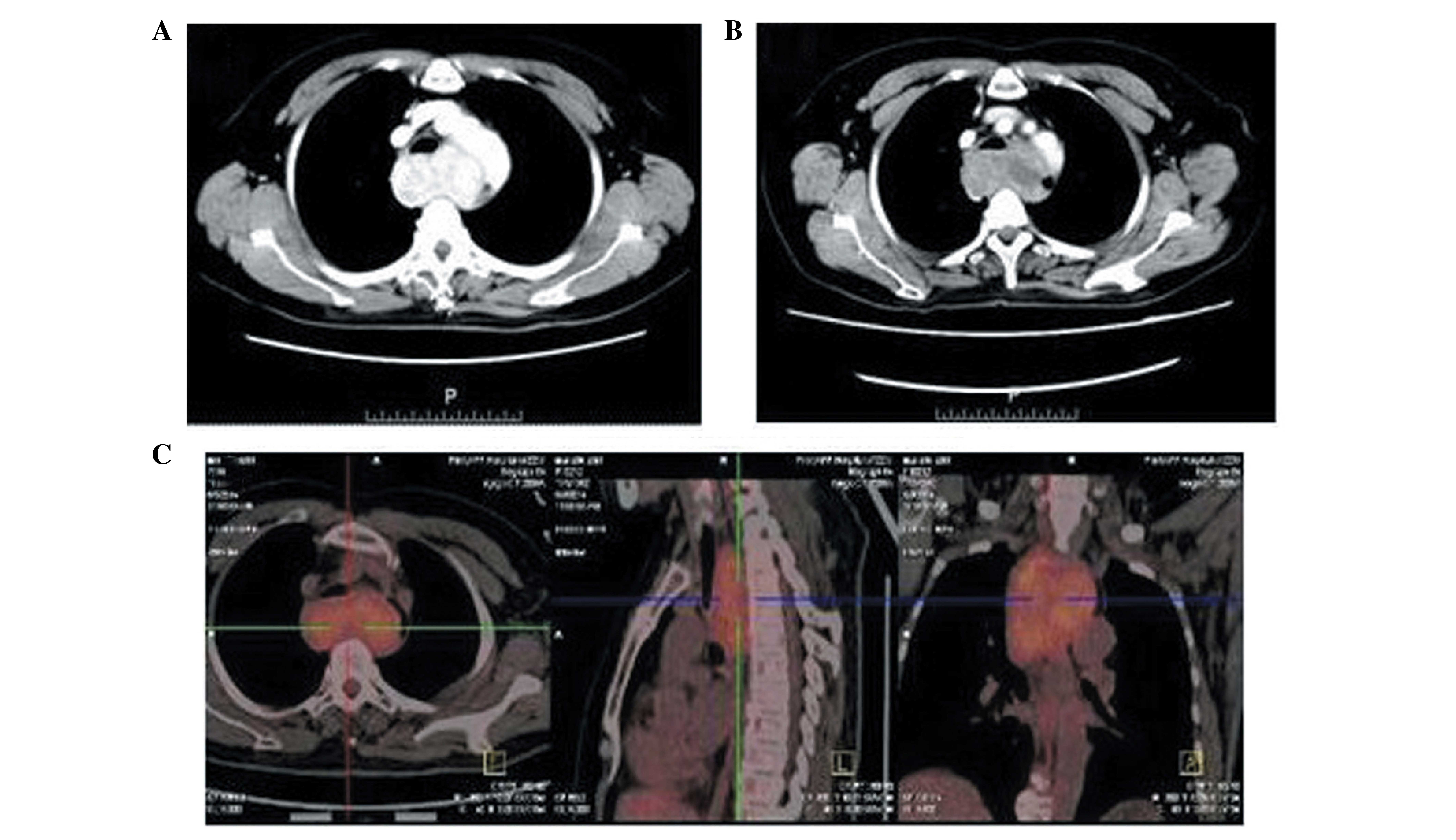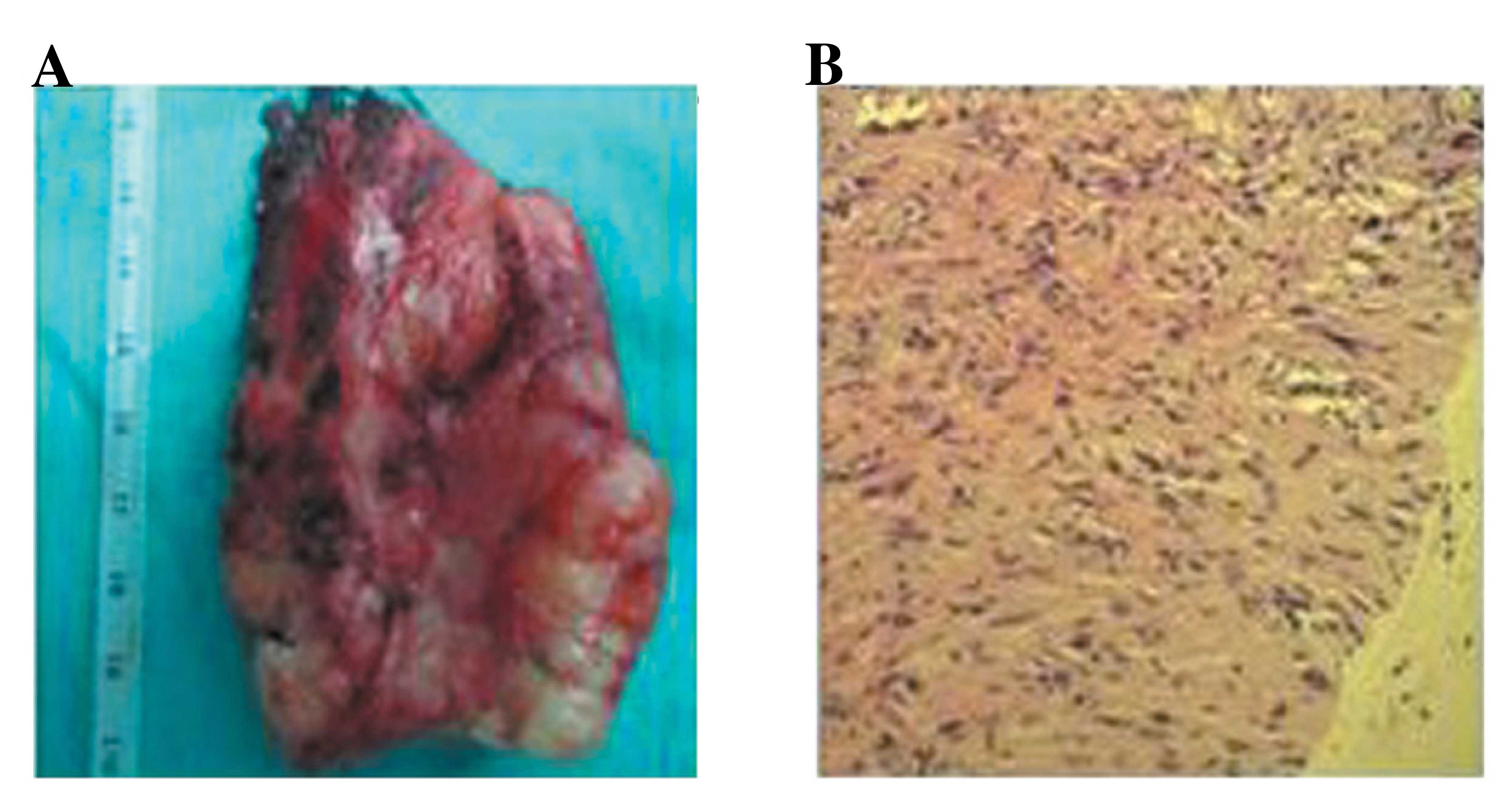Introduction
The majority of esophageal benign tumors are
leiomyomas, and schwannoma is rare (1). Esophageal schwannoma was first described
by Chatelin and Fissore in 1967 (2).
It is difficult to diagnose these tumors by endoscopy and imaging,
and they are finally diagnosed by pathological examination.
Surgical resection is the main treatment for esophageal schwannoma,
usually through a thoracotomy or esophagogastrostomy. Following
complete excision, the prognosis of schwannoma is generally good
and recurrence is rare (3). The
present study reports a case of esophageal schwannoma with
inhomogeneous enhancement following injection of contrast, in which
a partial esophagetomy was performed following embolization under
digital subtraction angiography (DSA). The study also describes the
clinical and pathological features of this unusual tumor.
Case report
A 62-year-old female presented to the First
Affiliated Hospital of Zhengzhou University (Zhengzhou, Henan,
China) in April 2014 with a 1-month history of dysphasia. A routine
medical examination and the family history were unremarkable. A
computed tomography (CT) scan of the chest showed a solid
mediastinal mass with a maximum diameter of 8 cm, with
inhomogeneous enhancement following injection of contrast. The mass
was compressing the trachea and esophagus (Fig. 1A). A hypermetabolic appearance
(maximum standardized uptake value, 4.8; Fig. 1B) was noted on positron emission
tomography (PET). Esophagoscopy demonstrated a smooth elevated
lesion, at a distance of 17–24 cm from the incisor teeth. Based on
these data, a mesenchymal tumor such as an esophageal leiomyoma was
suspected.
Next, DSA was performed and the main feeding artery
of tumor was shown to be the right thyrocervical trunk; 60 mg
cisplatin plus 1.0 mg fluorouracil infusion was administered and
embolization with a gelatin sponge was performed. Following the
embolization, the chest CT indicated that the tumor size had not
changed significantly, and there was a certain degree of necrosis
in the center of tumor, with no marked enhancement compared with
previously (Fig. 1C). A standard
right-sided posterolateral surgical procedure was performed through
the fifth intercostal space. The tumor was solid and
dumbbell-shaped, originating from the muscular layer of esophagus,
with no evident gaps between the esophageal mucosa and the
membranous region of the trachea. Once the esophageal schwannoma
had been enucleated, the esophageal mucosa and the membranous
region of the trachea were repaired with sutures. Methylene blue
was injected through the stomach tube and revealed no leakages.
On gross examination, the esophageal tumor was
revealed to be an irregular and tenacious mass of ~9 cm at the
greatest dimension (Fig. 2A).
Microscopic examination demonstrated spindle cells (Fig. 2B), with positive S-100 protein
expression and negative endothelial membrane antigen and desmin
expression, thus confirming the diagnosis of an esophageal
schwannoma. Approximately 3 weeks later, an upper gastrointestinal
angiography revealed an esophageal mucosa disorder, but the
contrast agent went through smoothly. The patient was gradually
transited from a liquid diet to a normal diet and was free of tumor
recurrence following surgery.
Discussion
The majority of esophageal tumors are malignant, and
benign primary tumors of the esophagus are uncommon, representing a
low percentage of all esophageal tumors (4). Esophageal schwannoma is a rare tumor,
with the majority of literature cases originating in Asia. Reviews
of previous case studies have recorded mediastinal masses with no
marked reinforcement on CT enhancement scanning (5–7), this
report indicated a benign esophageal schwannoma with inhomogeneous
enhancement on CT scanning. Following the embolization of DSA, a
thoracotomy with enucleation was performed to treat the schwannoma.
Final diagnosis was made on histological and immunohistochemical
basis: Esophageal schwannomas are typically characterized by
palisading spindle cells histologically and tumor cells are
immunohistochemically positive for S100, a characteristic marker of
Schwann cells (8). The main treatment
for esophageal schwannomas is surgical resection.
In summary, in the present study, a patient with a
benign esophageal schwannoma was successfully treated via DSA and
thoracotomy with enucleation. The final diagnosis of an esophageal
schwannoma was made by pathological examination. The present case
provides novel data suggesting that an esophageal schwannoma may
also have a rich blood supply, which requires assessment via
examinations prior to surgery.
References
|
1
|
Hsu SD, Cheng YL, Chen A and Lee SC:
Esophageal schwannoma. J Formos Med Assoc. 102:346–348.
2003.PubMed/NCBI
|
|
2
|
Chatelin CL and Fissore A: Shwanome
degenere de l'esophage. Confront Radio Anat Clin. 7:1141967.
|
|
3
|
Chen HC, Huang HJ, Wu CY, Lin TS and Fang
HY: Esophageal schwannoma with tracheal compression. Thorac
Cardiovasc Surg. 54:555–558. 2006. View Article : Google Scholar : PubMed/NCBI
|
|
4
|
Kitada M, Matsuda Y, Hayashi S, Ishibashi
K, Oikawa K and Miyokawa N: Esophageal schwannoma: A case report.
World J Surg Oncol. 11:2532013. View Article : Google Scholar : PubMed/NCBI
|
|
5
|
Liu T, Liu H, Yang C, Zhang X, Xu S and
Liu B: Benign esophageal schwannoma compressing the trachea
requiring esophagectomy: A case report. Thorac Cardiovasc Surg.
61:505–506. 2013. View Article : Google Scholar : PubMed/NCBI
|
|
6
|
Kassis ES, Bansal S, Perrino C, Walker JP,
Hitchcock C, Ross P Jr and Daniel VC: Giant asymptomatic primary
esophageal schwannoma. Ann Thorac Surg. 93:e81–e83. 2012.
View Article : Google Scholar : PubMed/NCBI
|
|
7
|
Jeon HW, Kim KS, Hyun KY and Park JK:
Enucleation of giant esophageal schwannoma of the upper thoracic
esophagus: Reports of two cases. World J Surg Oncol. 12:392014.
View Article : Google Scholar : PubMed/NCBI
|
|
8
|
Ferrante M, Khan A, Fan C and Jelloul FZ:
Schwannoma of the cervical esophagus. Rare Tumors. 6:53612014.
View Article : Google Scholar : PubMed/NCBI
|
















